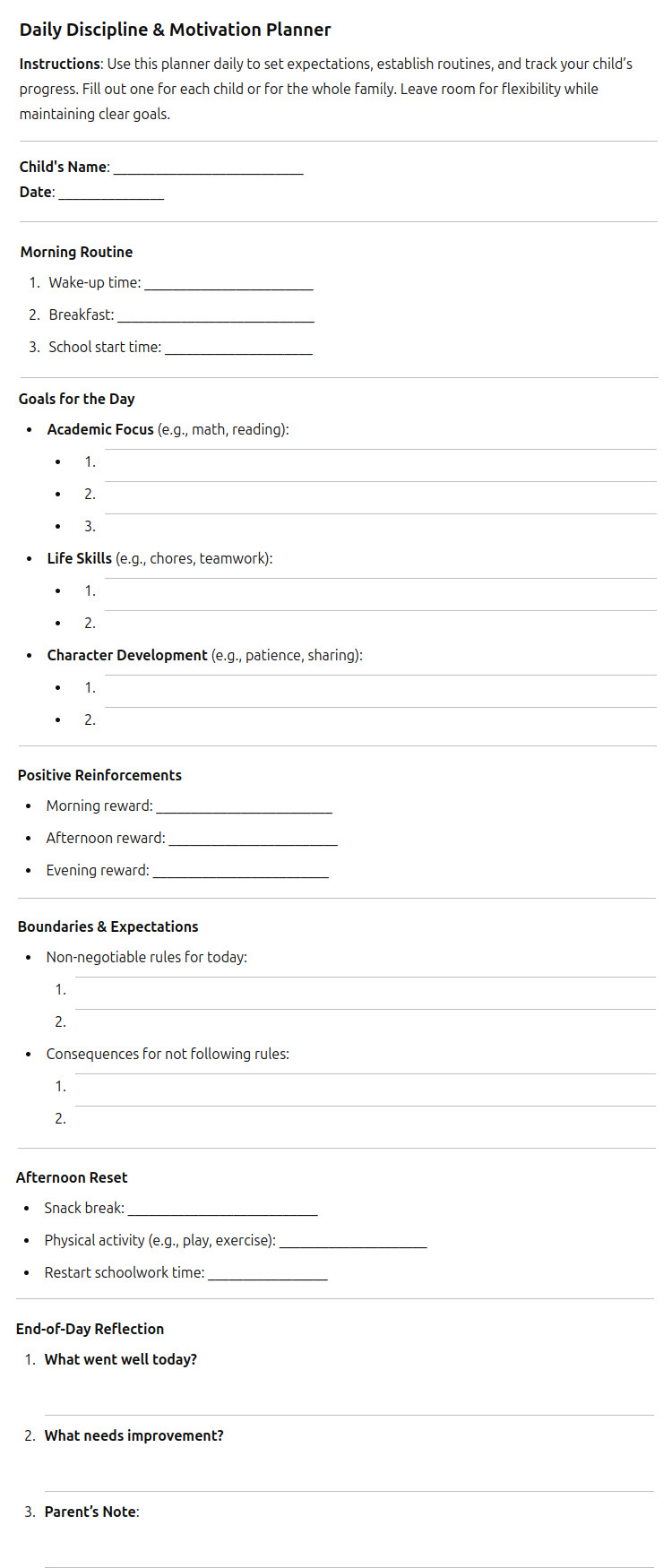Positive Discipline and Motivation:
A Guide for Homeschooling Families
A Guide for Homeschooling Families

Table of Contents
- Introduction: Why Positive Discipline Matters
- Setting the Tone: Routines and Boundaries
- Encouraging Self-Motivation
- Handling Challenges with Grace
- Tips for Long-Term Success
1. Introduction: Why Positive Discipline Matters
Homeschooling is a journey full of unique rewards and challenges. As someone who homeschooled seven children across three continents, I understand firsthand how critical it is to establish a balance of discipline and motivation in the home.
Positive discipline isn’t about harsh rules or constant correction—it’s about creating a structured, loving environment where children feel secure, capable, and eager to learn. With the right approach, you can achieve more learning in fewer hours, leaving time for exploration, play, and family bonding.
2. Setting the Tone: Routines and Boundaries
Children thrive in a predictable environment, and homeschooling offers the perfect opportunity to build one tailored to their needs.
Build Daily Routines
- Start each day at the same time to signal the beginning of “school.”
- Include breaks, meals, and downtime to maintain focus and prevent burnout.
- End the day with a clear wrap-up routine, like reviewing what was accomplished or setting goals for tomorrow.
Establish Clear Boundaries
- Create a dedicated learning space free from distractions like toys or electronics.
- Define rules for school hours, such as “no phone calls or gaming until after lessons.”
- Balance flexibility with structure by letting children help design their schedules while staying within your guidelines.
3. Encouraging Self-Motivation
Self-motivation is a skill that will serve your children for life. Here’s how to foster it:
Set Achievable Goals
- Break larger assignments into smaller, manageable tasks.
- Use a visual chart or planner to track progress—it’s rewarding for kids to see what they’ve accomplished.
Incorporate Their Interests
- Allow children to explore topics they’re passionate about within their studies.
- For example, if a child loves dinosaurs, tie them into science or history lessons.
Celebrate Success
- Praise effort, not just results: “I saw how hard you worked on that math problem!”
- Use small rewards for milestones, like a family movie night or an extra recess break.
4. Handling Challenges with Grace
Every homeschooling family faces tough days. When discipline falters or motivation wanes, these strategies can help:
Stay Calm and Consistent
- Avoid reacting emotionally to misbehavior. Take a deep breath and address the issue calmly.
- Consistent consequences build trust and help children understand boundaries.
Reassess and Adjust
- If a lesson isn’t going well, step back and find a different approach.
- Check for underlying issues—are they hungry, tired, or frustrated with the material?
Take Breaks
- Sometimes everyone needs a breather. A 10-minute walk or a quick snack break can reset the mood.
5. Tips for Long-Term Success
Model the Behavior You Want
Children are natural imitators. Show patience, perseverance, and enthusiasm for learning, and they’ll follow suit.
Involve the Whole Family
- Let siblings work together on group projects or help each other with tasks.
- Assign age-appropriate chores to foster responsibility and teamwork.
Keep the Big Picture in Mind
- Remember, homeschooling is a marathon, not a sprint. Focus on steady progress, not perfection.
- Celebrate your family’s unique journey and adapt as needed.
Final Thoughts
Homeschooling is as much about teaching life skills as it is about academics. Discipline and motivation are key to creating a thriving homeschool environment where children feel loved, respected, and inspired.
I have learned over the years that a positive approach builds the strongest foundation for both learning and family bonds. Use this guide as a starting point, and don’t be afraid to tweak it to suit your family’s needs. You’ve got this!
Daily Discipline & Motivation Planner
Instructions: Use this planner daily to set expectations, establish routines, and track your child’s progress. Fill out one for each child or for the whole family. Leave room for flexibility while maintaining clear goals.

